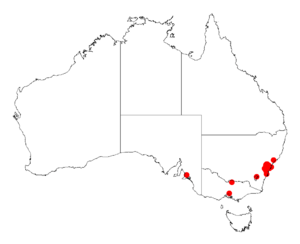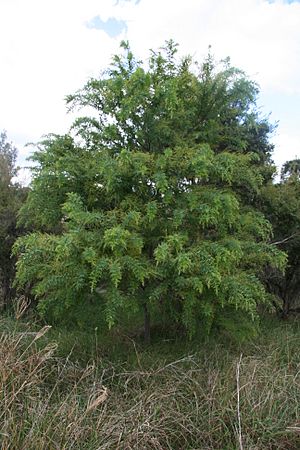Downy wattle facts for kids
Quick facts for kids Downy wattle |
|
|---|---|
 |
|
| Conservation status | |
| Scientific classification | |
| Genus: |
Acacia
|
| Species: |
pubescens
|
 |
|
| Occurrence data from AVH | |
| Synonyms | |
|
Racosperma pubescens (Vent.) Pedley |
|
The Acacia pubescens, also known as the downy wattle, is a special type of wattle tree. You can find it in the Sydney Basin area of eastern New South Wales, Australia. This plant is considered vulnerable, which means it's at risk of disappearing. A big reason for this is that much of its natural home has been lost as the city of Sydney has grown.
The downy wattle can grow as a shrub or a small tree. It usually reaches a height of 1 to 5 meters (about 3 to 16 feet). Like all wattles, it doesn't have regular leaves. Instead, it has leaf-like parts called phyllodes. These phyllodes are made up of smaller sections and are about 1.5 to 6.5 centimeters (0.6 to 2.6 inches) long. In spring, usually from August to October, the plant blooms with round, yellow flowers.
What Does It Look Like?
The Acacia pubescens can be a shrub or a small tree. It grows to be about 1 to 5 meters (3 to 16 feet) tall. Its bark is smooth and grey-brown. Sometimes, its branches hang down a little, which looks nice.
Instead of normal leaves, the downy wattle has special leaf-like parts called phyllodes. These phyllodes are divided into smaller "leaves" or pinnae. Each phyllode is about 1.5 to 6.5 centimeters (0.6 to 2.6 inches) long. They have 3 to 12 pairs of these smaller pinnae. Each pinna is about 0.5 to 2.5 centimeters (0.2 to 1 inch) long and is also made of even tinier parts.
In spring, from August to October, you can see its beautiful flowers. These flowers are round and bright yellow. They grow in clusters along the branches.
Naming the Downy Wattle
A French plant expert named Étienne Pierre Ventenat first described the downy wattle in 1803. He called it Mimosa pubescens. This plant was growing in the garden of Empress Joséphine de Beauharnais at the Château de Malmaison.
Later, in 1813, another botanist named Robert Brown gave it its current name, Acacia pubescens. People also call it the "hairy-stemmed wattle." The name pubescens comes from a Latin word meaning "hairy." This refers to the slightly hairy stems of the plant.
For a while, some scientists thought it should be in a different group called Racosperma. But now, its original name, Acacia pubescens, is still the correct one.
Sometimes, the downy wattle can even mix with other wattle types. For example, it has been known to create natural mixes with the Cootamundra wattle (Acacia baileyana). It can also mix with the West Wyalong wattle (A. cardiophylla).
Where It Lives
The Acacia pubescens only grows in New South Wales, Australia. It is found in scattered groups within the Sydney Basin. You can find it in places like Bardwell Valley, Oakdale, and Mountain Lagoon.
Most of these plants are located around Bankstown, Fairfield, and Rookwood in southwestern Sydney. Some are also in Pitt Town, in the city's northwest. Sadly, a lot of its natural home has been lost. This happened as Sydney's suburbs grew bigger. Because of this, the downy wattle is now listed as a "Vulnerable" plant.
It likes to grow in clay soils. You can often find it in open sclerophyll forests. It grows alongside other plants like grey box (Eucalyptus moluccana), broad-leaved ironbark (E. fibrosa), white feather honeymyrtle (Melaleuca decora), and blackthorn (Bursaria spinosa).
How It Lives
Scientists believe that Acacia pubescens plants can live for up to 50 years in the wild. This is a long time for a plant!
They also have a special ability to survive bushfires. After a fire, they can grow back from their roots. This is called "resprouting" and helps them recover from natural disasters.



